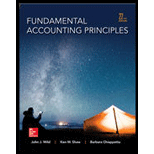
Issue of bond at discount:
When the coupon rate or contract rate of a bond is lower than the market interest rate, the bond is being issued at discount. The selling price of the bond will be lower than the face value of the bond under issue of bond at discount.
Under straight line amortization method, a specific amount of discount is amortized each period till its maturity period. The period ending amortization amount is computed by dividing the total discount by the number of periods in maturity of the bonds payable.
To determine:
1. Preparation of
2. Computation of (a) the cash payment, (b) the straight-line discount amortization, and (c) the bond interest expense
3. Determine to total bond interest expense to be recognized over the life of the bonds.
4. Prepare the first two years of an amortization table using straight-line method.
5. Prepare the journal entries to record the first two interest payments.
Want to see the full answer?
Check out a sample textbook solution
Chapter 14 Solutions
Fundamental Accounting Principles -Hardcover
- Laura estimates that his car costs $290 per month in fixed expenses, such as insurance and registration. Additionally, he calculates gas, oil, and maintenance at 16 cents per mile. Laura typically drives 1,250 miles each month on average. How much would Laura expect his total car costs to be in May if he drives 1,680 miles? help mearrow_forwardCorrect answer pleasearrow_forwardFinancial Accountingarrow_forward
- The total manufacturing costs added during the period are?arrow_forwardCash: 35000, Accounting receivable: 52000arrow_forwardThe actual cost of direct labor per hour is $16.25 and the standard cost of direct labor per hour is $15.00. The direct labor hours allowed per finished unit is 0.60 hours. During the current period, 4,500 units of finished goods were produced using 2,900 direct labor hours. How much is the direct labor rate variance? A. $3,625 favorable B. $3,625 unfavorable C. $4,350 favorable D. $4,350 unfavorablearrow_forward
- Please provide correct solution and accounting questionarrow_forwardA balance sheet shows cash, $75,000; marketable securities, $110,000; receivables, $90,000; and $225,000 of inventories. Current liabilities are $200,000. The current ratio is 1.375 to 1. a. True b. Falsearrow_forwardWhat is the economic order quantity?arrow_forward

 AccountingAccountingISBN:9781337272094Author:WARREN, Carl S., Reeve, James M., Duchac, Jonathan E.Publisher:Cengage Learning,
AccountingAccountingISBN:9781337272094Author:WARREN, Carl S., Reeve, James M., Duchac, Jonathan E.Publisher:Cengage Learning, Accounting Information SystemsAccountingISBN:9781337619202Author:Hall, James A.Publisher:Cengage Learning,
Accounting Information SystemsAccountingISBN:9781337619202Author:Hall, James A.Publisher:Cengage Learning, Horngren's Cost Accounting: A Managerial Emphasis...AccountingISBN:9780134475585Author:Srikant M. Datar, Madhav V. RajanPublisher:PEARSON
Horngren's Cost Accounting: A Managerial Emphasis...AccountingISBN:9780134475585Author:Srikant M. Datar, Madhav V. RajanPublisher:PEARSON Intermediate AccountingAccountingISBN:9781259722660Author:J. David Spiceland, Mark W. Nelson, Wayne M ThomasPublisher:McGraw-Hill Education
Intermediate AccountingAccountingISBN:9781259722660Author:J. David Spiceland, Mark W. Nelson, Wayne M ThomasPublisher:McGraw-Hill Education Financial and Managerial AccountingAccountingISBN:9781259726705Author:John J Wild, Ken W. Shaw, Barbara Chiappetta Fundamental Accounting PrinciplesPublisher:McGraw-Hill Education
Financial and Managerial AccountingAccountingISBN:9781259726705Author:John J Wild, Ken W. Shaw, Barbara Chiappetta Fundamental Accounting PrinciplesPublisher:McGraw-Hill Education





